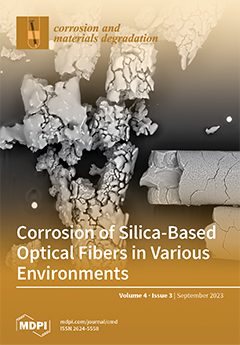Journal Article from Virginia Tech and Luna Featured on the Cover of Corrosion and Materials Degradation
A research article, Corrosion of Silica-Based Optical Fibers in Various Environments, produced by the team of Dr. Amanda Leong (Virginia Tech), Dr. Steven Rountree (Luna), and Dr. Jinsuo Zhang (Virginia Tech) was recently featured on the cover of the journal Corrosion and Materials Degradation. The study focuses on investigating the material compatibility of optical fibers in challenging sensing environments like Gen II/II+ and advanced nuclear reactors, as well as concentrated solar power (CSP) plants. Material compatibility tests were conducted to determine the effects of different fiber chemistries and coatings in molten salt environments.
 Utilizing fiber optics, such as those compatible with Luna’s ODiSI and HYPERION systems, as sensory indicators in nuclear power plants offers numerous advantages. Notably, fiber optics are immune to electromagnetic interference, and their compact size enables multiple sensors to be accommodated through a single reactor vessel feedthrough, allowing for the measurement of multiple environmental parameters through inline sensor multiplexing. Ensuring the safety and reliability of a power plant requires a comprehensive understanding of the operating environment, and sensors play a crucial role in providing valuable information to operators. Traditional sensor systems have limitations, such as occupying significant space due to the need for multiple sensing locations and various sensors for measuring different parameters, including temperature, pressure, strain, neutron fluence, and more. Unlike traditional sensors, optical fiber sensors do not require an electrically conductive path to and from the sensor. With a typical fiber optic diameter of 125 µm, multiple fibers can be easily accommodated through a single instrumentation port for measuring various parameters simultaneously.
Utilizing fiber optics, such as those compatible with Luna’s ODiSI and HYPERION systems, as sensory indicators in nuclear power plants offers numerous advantages. Notably, fiber optics are immune to electromagnetic interference, and their compact size enables multiple sensors to be accommodated through a single reactor vessel feedthrough, allowing for the measurement of multiple environmental parameters through inline sensor multiplexing. Ensuring the safety and reliability of a power plant requires a comprehensive understanding of the operating environment, and sensors play a crucial role in providing valuable information to operators. Traditional sensor systems have limitations, such as occupying significant space due to the need for multiple sensing locations and various sensors for measuring different parameters, including temperature, pressure, strain, neutron fluence, and more. Unlike traditional sensors, optical fiber sensors do not require an electrically conductive path to and from the sensor. With a typical fiber optic diameter of 125 µm, multiple fibers can be easily accommodated through a single instrumentation port for measuring various parameters simultaneously.
This study investigated the corrosion behavior of fibers in extreme high-temperature environments, including steam, FLiNaK, MgCl₂-NaCl-KCl, LBE, and pressurized water reactors. The results revealed that fibers exhibited good performance in the LBE environment, followed by molten MgCl₂-NaCl-KCl, and discussed ways to mitigate risks in other, similar environments. By addressing these challenges, optical fibers could find increased utility in industries such as nuclear power plants, concentrated solar power plants, and other high-temperature and chemically aggressive environments, where their immunity to electromagnetic interference and ability to withstand harsh conditions are advantageous.
Studies of this nature demonstrating the viability of fiber optic sensing in harsh environments are key to building acceptance within the industry. Luna’s diverse fiber optic sensing portfolio enables advanced instrumentation for the nuclear and energy industries.
To learn more about Luna Innovations fiber optic sensing technology please contact us at [email protected].
Acknowledgments:
- This material is based upon work supported by the U.S. Department of Energy, Office of Science, SC-1 under Award Number DE-SC0017826 issued through the Small Business Innovation Research (SBIR) Program
- This work used shared facilities at the Nanoscale Characterization and Fabrication Laboratory, funded and managed by Virginia Tech’s Institute for Critical Technology and Applied Science. Additional support is provided by the Virginia Tech National Center for Earth and Environmental Nanotechnology Infrastructure (NanoEarth), a member of the National Nanotechnology Coordinated Infrastructure (NNCI), supported by NSF (ECCS 1542100 and ECCS 2025151).
References:
- Leong, A.; Rountree, S.D.; Zhang, J. Corrosion of Silica-Based Optical Fibers in Various Environments. Corros. Mater. Degrad. 2023, 4, 445-465. https://doi.org/10.3390/cmd4030023